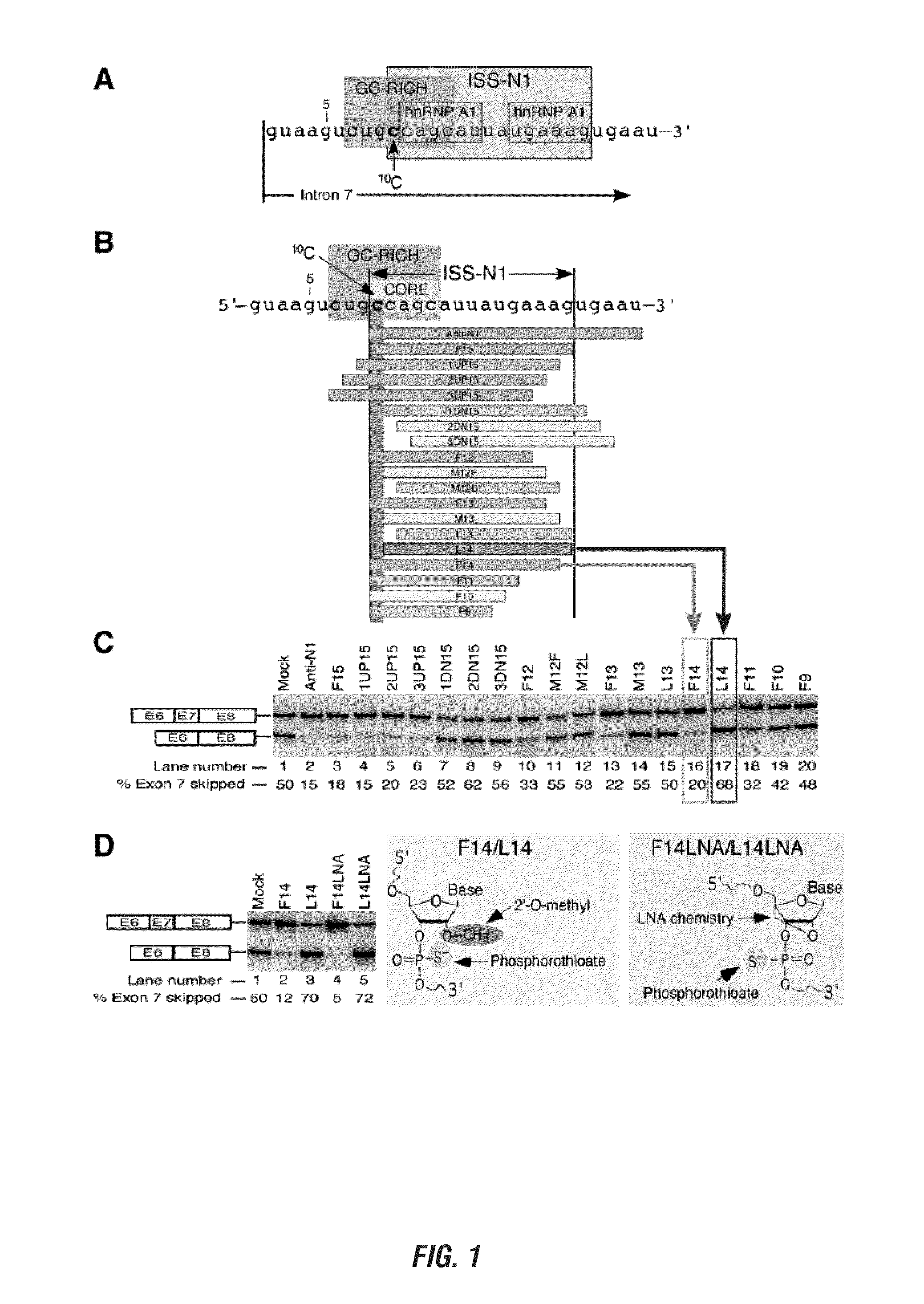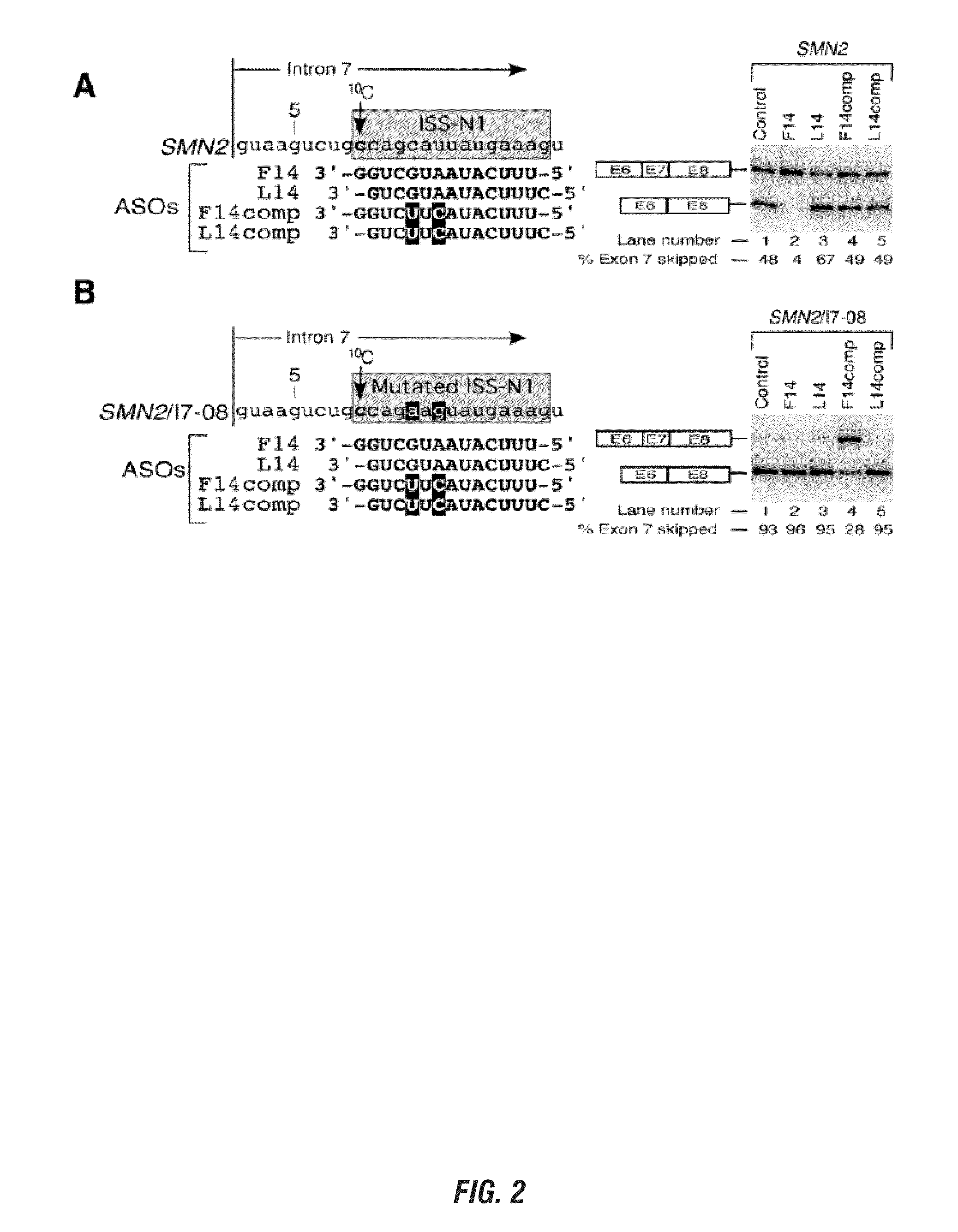Spinal muscular atrophy treatment via targeting smn2 catalytic core
a catalytic core and spine technology, applied in the direction of skeletal/connective tissue cells, drug compositions, muscular disorders, etc., can solve the problems of no drug therapy available for treatment or prevention, and achieve the effect of restoring the production of full-length smn protein, enhancing the production of full-length smn2 transcripts, and effective use of blocking agents
- Summary
- Abstract
- Description
- Claims
- Application Information
AI Technical Summary
Benefits of technology
Problems solved by technology
Method used
Image
Examples
example 1
[0168]Modulation of aberrant splicing using antisense oliogonucleotides (ASOs) is an emerging technology with tremendous therapeutic potential. An ASO-based approach could be also employed to determine unique interactions that are difficult to uncover using traditional means of deletion and substitution mutations. Here we report a novel finding of an antisense microwalk in which we examined the position-specific role of intronic residues downstream of the 5′ splice site (5′ ss) of SMN2 exon 7, skipping of which is associated with Spinal Muscular Atrophy (SMA), a leading genetic cause of infant mortality. Our results revealed the inhibitory role of a cytosine residue at the 10th intronic position (10C), which is neither conserved nor associated with any known splicing motif Significance of 10C emerged from the splicing pattern of SMN2 exon 7 in presence of a 14-mer ASO (L14) that sequestered two adjacent hnRNP A1 motifs downstream of 10C and yet promoted SMN2 exon 7 skipping. Another...
example 2
Materials and Methods
[0256]Plasmids, cells and ASOs. Construction of SMN2 minigene is described earlier.35 Construct SMN2 / 64A contains a C-to-A mutation in SMN2 minigene and was generated by PCR using Phusion High-Fidelity DNA polymerase (New England Biolabs). HeLa cells were obtained from the American Type Culture Collection and were cultured in Dulbecco's modified Eagle's medium (DMEM) supplemented with 10% fetal bovine serum (FBS). Primary fibroblast cell line from SMA type I patient (Repository number GM03813) and a healthy control (Repository number AG06814) were obtained from Coriell Cell Repositories. These cells were maintained in MEM supplemented with 2 mM GlutaMAX-I and 15% FBS. All tissue culture media and supplements were purchased from Invitrogen. RNA ASOs used in our study were synthesized by Dharmacon Inc. These ASOs incorporated 2′-O-methyl modification and phosphorothioate backbone (2OMePS) as described earlier.
[0257]Transfections and in vivo splicing assays. Transi...
PUM
| Property | Measurement | Unit |
|---|---|---|
| Tm | aaaaa | aaaaa |
| Tm | aaaaa | aaaaa |
| Tm | aaaaa | aaaaa |
Abstract
Description
Claims
Application Information
 Login to View More
Login to View More - R&D
- Intellectual Property
- Life Sciences
- Materials
- Tech Scout
- Unparalleled Data Quality
- Higher Quality Content
- 60% Fewer Hallucinations
Browse by: Latest US Patents, China's latest patents, Technical Efficacy Thesaurus, Application Domain, Technology Topic, Popular Technical Reports.
© 2025 PatSnap. All rights reserved.Legal|Privacy policy|Modern Slavery Act Transparency Statement|Sitemap|About US| Contact US: help@patsnap.com



